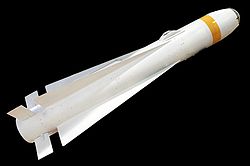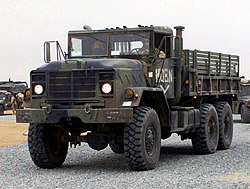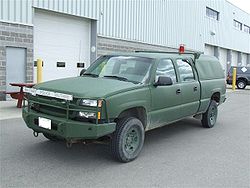The equipment of the United States Navy has been subdivided into: watercraft, aircraft, munitions, vehicles, and small arms.
The equipment of the United States Navy has been subdivided into: watercraft, aircraft, munitions, vehicles, and small arms.
Commissioned submarines and surface ships (arranged by class and displacement)
| Boat | Image | Armament | Notes |
|---|---|---|---|
| LCU 1627 |  | 4x turret mounts[single] : [ Mk 19 40 mm, GAU-19 .50 in, M2HB .50 in, GSU-17 7.62 mm, M240B 7.62 mm] | Wasp-class amphibious assault ship, America-class amphibious assault ship, Watson-class vehicle cargo ship |
| LCU 2000 |  | ||
| LCU 1700 | 4x turret mounts[single] : [ Mk 19 40 mm, GAU-19 .50 in, M2HB .50 in, GSU-17 7.62 mm, M240B 7.62 mm] | Wasp-class amphibious assault ship, America-class amphibious assault ship, Watson-class vehicle cargo ship | |
| LCAC |  | 4x turret mounts[single] : [ Mk 19 40 mm, GAU-19 .50 in, M2HB .50 in, GSU-17 7.62 mm, M240B 7.62 mm] | Wasp-class amphibious assault ship, America-class amphibious assault ship, Watson-class vehicle cargo ship |
| Aircraft | Image | Origin | Type | Variant | In service | Notes |
|---|---|---|---|---|---|---|
| Combat Aircraft | ||||||
| F/A-18 Super Hornet |  | United States | Multirole | F/A-18E/F | 421 [2] | 76 on order [2] |
| F-35 Lightning II |  | United States | Multirole | F-35C | 30 [2] | 16+188 on order [2] |
| Electronic Warfare and Signals Intelligence | ||||||
| E-2 Hawkeye |  | United States | Carrier capable airborne early warning | E-2C/D | 97 [3] | 27 on order [3] |
| EP-3 ARIES II |  | United States | Signals Intelligence | EP-3E | 12 [3] | |
| E-6 Mercury |  | United States | Airborne command and control | E-6B | 16 [3] | Being replaced by E-130J |
| EA-18 Growler |  | United States | Electronic warfare | EA-18G | 152 [3] | |
| Maritime Patrol | ||||||
| P-3 Orion |  | United States | Maritime patrol | P-3C | 28 [3] | To be replaced by the P-8 Poseidon. [4] |
| P-8 Poseidon |  | United States | Maritime patrol | P-8A | 112 [3] | 18 on order [3] |
| Tanker | ||||||
| KC-130 Hercules |  | United States | Aerial refueling/transport | KC-130T | 10 [3] | |
| Transport | ||||||
| C-2 Greyhound |  | United States | Carrier based transport | C-2A | 33 [3] | Planned to be Replaced with V-22 Osprey |
| C-12 Huron |  | United States | Transport | UC-12 | 13 [3] | |
| C-20 Grey Ghost |  | United States | Transport | C-20G | 3 [3] | |
| C-26 Metroliner |  | United States | Transport | C-26D | 8 [3] | |
| C-38 Courier |  | Israel | Transport | C-38A | 2 [3] | |
| C-40 Clipper |  | United States | Transport | C-40A | 17 [3] | |
| C-130 Hercules |  | United States | Transport | C-130T | 17 [3] | |
| C-130J Super Hercules |  | United States | Transport | C-130J | 1 [3] | |
| Rotorcraft | ||||||
| V-22 Osprey |  | United States | Tiltrotor | CMV-22B | 12 [3] | 49 on order [3] Gradual replacement for the C-2 Greyhound [5] |
| MH-53 Sea Dragon |  | United States | Multi-mission helicopter | MH-53E | 29 [3] | |
| HH-60 Rescue Hawk |  | United States | Search and rescue helicopter | HH-60H | 8 [3] | |
| MH-60 Seahawk |  | United States | Anti-submarine warfare helicopter | MH-60R MH-60S | 561 [3] | |
| SH-60 Seahawk |  | United States | Anti-submarine warfare helicopter | SH-60B SH-60F | 189 [3] | |
| Trainer Aircraft | ||||||
| TH-57 Sea Ranger |  | United States | Training helicopter | TH-57B TH-57C | 115 [3] | |
| UH-72 Lakota |  | Multinational | Training helicopter | UH-72A | 5 [3] | |
| TH-73 Thrasher |  | Italy / United States | Training helicopter | TH-73A | 3 [3] | 128 on order [3] |
| U-1 Otter |  | Canada | Trainer | U-1B | 1 [3] | Otter NU-1B is the oldest aircraft in the U.S. Navy, in service at the U.S. Naval Test Pilot School, Patuxent River, Md. [6] |
| U-6 Beaver |  | Canada | Trainer | U-6A | 2 [3] | |
| F-5 Tiger II |  | United States | Adversary trainer | F-5F F-5N | 31 [3] | |
| F-16 Fighting Falcon |  | United States | Adversary trainer | F-16A F-16B | 14 [3] | |
| F/A-18 Hornet |  | United States | Trainer | F/A-18A/B/C/D/E/F | 183 [3] | Operated by reserve, training and development squadrons in a role described as "non-deployable". [7] [8] While the F/A-18C is possessed by the Navy Reserve Strike fighter squadron VFA-204, due to their unsuitability in combat situations in regards to their lack of modern avionics, communications equipment and weapons integration, they are used solely as an adversary/aggressor trainer. [9] [10] |
| T-6 Texan II |  | United States | Trainer | T-6A T-6B T-6C | 293 [3] | 29 on order |
| T-34 Mentor |  | United States | Trainer | T-34C | 13 [3] | |
| T-38 Talon |  | United States | Supersonic jet trainer | T-38A | 10 [3] | |
| T-44 Pegasus |  | United States | Multi-engine trainer | T-44A | 56 [3] | |
| T-45 Goshawk |  | United Kingdom / United States | Carrier based trainer | T-45C | 191 [3] | |
| Unmanned Aerial Systems | ||||||
| MQ-4C Triton |  | United States | Surveillance & patrol aircraft | MQ-4 | 30 | |
| MQ-8 Fire Scout |  | United States | UAV helicopter | MQ-8A MQ-8B | 30 | |
| MQ-8C Fire Scout |  | United States | UAV helicopter | MQ-8C | 19 | [11] |
| Boeing MQ-25 Stingray |  | United States | UAV Aerial refueling | MQ-25 T1 | 1 | 72 planned [12] |
| Name | Image | Type | Versions | Name | Image | Type | Versions |
|---|---|---|---|---|---|---|---|
| MK84 |  | General-purpose bomb | AIM-7 |  | Medium-range, semi-active radar homing air-to-air missile | AIM-7A, AIM-7B, AIM-7C, AIM-7D, AIM-7E, AIM-7E2, AIM-7F, AIM-7M, AIM-7P, and RIM-7M | |
| CBU-78 | | Air-dropped anti-tank and anti-personnel mines | CBU-78/B | AIM-9 |  | Short-range air-to-air missile | AIM-9D, AIM-9G, AIM-9H, AIM-9L, AIM-9M, AIM-9R, and AIM-9X |
| MK83 |  | General-purpose bomb | BLU-110 | AIM-120 |  | Medium-range, active radar homing air-to-air missile | AIM-120A, AIM-120B, AIM-120C, AIM-120C-4/5/6/7, AIM-120D |
| CBU-100 |  | Cluster bomb | MK82 |  | General-purpose bomb | BLU-111/B, BLU-111A/B, BLU-126/B | |
| AGM-65 |  | Guided air-to-surface missile | AGM-65A/B, AGM-65D, AGM-65E, AGM-65F/G, AGM-65H, AGM-65J, and AGM-65K | AGM-84 |  | Anti-ship missile | AGM-84, RGM-84, and UGM-84 |
| AGM-88 |  | Air-to-surface anti-radiation missile | AGM-88E AARGM | AGM-154 |  | Glide bomb | AGM-154A, AGM-154B, AGM-154C |
| AGM-114 |  | Guided air-to-surface missile | AGM-114B, AGM-114K, AGM-114M | BGM-109 |  | cruise missile | BGM-109C, BGM-109D, RGM-109E, UGM-109E |
| RIM-116 |  | Close-in weapons system | RIM-116A, RIM-116B | UGM-133 |  | SLBM | UGM-133 Trident II |
| RIM-162 |  | Surface-to-air missile | RIM-162 ESSM | RIM-66 | | Surface-to-air missile | RIM-66K, RIM-66L, RIM-66M |
| RIM-174A Standard ERAM |  | Surface-to-air missile | RIM-174A Block IA, RIM-174A Block IB | RIM-161 |  | Anti-ballistic missile | RIM-161C |
| GBU-10 | Prescision-Guided | BLU-109 | Bunker Buster | ||||
| GBU-12 | Prescision-Guided | BLU-110 | General-purpose bomb | ||||
| GBU-16 | Prescision-Guided | BLU-111 | General-purpose bomb | ||||
| GBU-24 | Prescision-Guided | GBU-31 | Prescision-Guided | ||||
| GBU-32 | Prescision-Guided | GBU-38 | Prescision-Guided | ||||
| GBU-51 | Prescision-Guided | GBU-39 | Prescision-Guided | ||||
| GBU-53 | Prescision-Guided | GBU-49 | Prescision-Guided | ||||
| GBU-54 | Prescision-Guided | GBU-61 | Countermine System | ||||
| MK62 | Navy Mines | MK63 | Navy Mines | ||||
| MK65 | Navy Mines | MK67 | Submarine Launch Mines | ||||
| Mark 48 | Torpedo | Mark 54 | Torpedo |
In addition to the vehicles listed here, the Navy Seabees operate a number of unlisted trucks and construction vehicles.
| Name | Image | Type | Notes |
|---|---|---|---|
| M939 |  | Utility vehicle | Used primarily by Expeditionary Forces |
| FMTV |  | Utility vehicle | Used primarily by Expeditionary Forces |
| MTVR |  | 6x6 tactical truck | Used by Navy Seabees |
| HMMWV |  | Light utility vehicle | Used primarily by Expeditionary Forces. To be replaced by M-ATV and JLTV. |
| Oshkosh M-ATV |  | MRAP, LUV | To replace HMMWV, used by Navy Special Warfare and Explosive Ordnance Disposal (EOD) teams. |
| Oshkosh JLTV |  | light multi-role vehicle/light tactical vehicle and MRAP | To replace HMMWV, used by Navy Special Warfare teams |
| Buffalo |  | MRAP | Used by Explosive Ordnance Disposal (EOD) and Navy Seabees |
| Cougar |  | MRAP and IFV | H (4x4) / HE (6x6) variants both used by Explosive Ordnance Disposal (EOD) and Navy Seabees |
| LARC-V |  | amphibious vehicle | Used by amphibious naval beach units |
| DPV |  | Patrol vehicle | to be replaced by ALSV |
| ALSV |  | Special Attack Vehicle | Replacing DPV |
| IFAV |  | LUV | |
| LSSV |  | Multi-purpose vehicle | Used by Navy Special Warfare teams for various missions |
| Model | Image | Type | Variants | Details | ||
|---|---|---|---|---|---|---|
| Uniform equipment | ||||||
| NWU combat uniform | battledress | Type III (woodland), Type II (desert), and Type I (canceled) | standard issue Naval issue combat uniform | |||
| MARPAT |  | Camouflage pattern | Desert, Woodland, Winter, Urban (prototype) | Limited-issue for certain positions | ||
| Advanced Bomb Suit |  | bomb suit | Used by Explosive Ordnance Disposal teams | |||
| Interceptor Body Armor |  | ballistic vest | U.S. Woodland, Coyote Tan, Desert camouflage or "Chocolate Chip" uniform, and Universal Camouflage Pattern | May be replaced by Combat Integrated Releasable Armor System or various ballistic vests like the Improved Modular Tactical Vest and Improved Scalable Plate Carrier used by the U.S. Marine Corps | ||
| Combat Integrated Releasable Armor System |  | modular ballistic vest | Replaces the Full Spectrum Battle Equipment Amphibious Assault Vest | |||
| Enhanced Combat Helmet |  | Combat helmet | Replaces Advanced Combat Helmet and Lightweight Helmet | |||